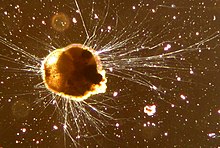Rhizaria
infrakingdom of protists
The Rhizaria are a supergroup of mostly unicellular eukaryotes.[1][2] A multicellular form has recently been described.[3]
| Rhizaria Temporal range: Neoproterozoic - Recent
| |
|---|---|

| |
| Ammonia tepida (Foraminifera) | |
| Scientific classification | |
| Domain: | Eukaryota |
| Clade: | Diaphoretickes |
| Clade: | TSAR |
| Clade: | SAR |
| (unranked): | Rhizaria Cavalier-Smith, 2002 |
| Phyla | |
This supergroup was proposed by Cavalier-Smith in 2002.[4] It has many species. They vary considerably in form, but for the most part they are amoeba-like with pseudopods. Many produce shells or skeletons, which may be quite complex in structure. They make up the vast majority of protozoan fossils. Nearly all have mitochondria with folds.
Groups
changeThere are three main groups of Rhizaria:[5]
- Cercozoa – Various amoebae and flagellates, usually with pseudopods and common in soil
- Foraminifera – Amoeboids with reticulose pseudopods, common as marine benthos
- Radiolaria – Amoeboids with skeletons, common as marine plankton
References
change- ↑ Christopher Taylor (2004). "Rhizaria". Archived from the original on 2009-04-20. Retrieved 2014-07-04.
- ↑ Nikolaev S.I.; et al. (2004). "The twilight of Heliozoa and rise of Rhizaria, an emerging supergroup of amoeboid eukaryotes". Proc. Natl. Acad. Sci. U.S.A. 101 (21): 8066–71. doi:10.1073/pnas.0308602101. PMC 419558. PMID 15148395.
- ↑ Brown; et al. (2012). "Aggregative multicellularity evolved independently in the Eukaryotic Supergroup Rhizaria". Current Biology : Cb. 22 (12): 1123–1127. doi:10.1016/j.cub.2012.04.021. PMID 22608512. S2CID 17510471.
- ↑ Cavalier-Smith, Thomas (2002). "The phagotrophic origin of eukaryotes and phylogenetic classification of Protozoa". International Journal of Systematic and Evolutionary Microbiology. 52 (2): 297–354. doi:10.1099/00207713-52-2-297. ISSN 1466-5026. PMID 11931142. Archived from the original on 2010-12-24. Retrieved 2007-06-08.
- ↑ Moreira D.; et al. (2007). "Global eukaryote phylogeny: combined small- and large-subunit ribosomal DNA trees support monophyly of Rhizaria, Retaria and Excavata". Mol. Phylogenet. Evol. 44 (1): 255–66. doi:10.1016/j.ympev.2006.11.001. PMID 17174576.